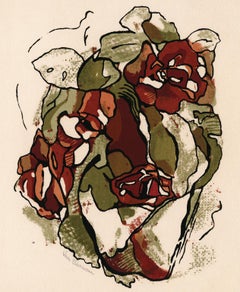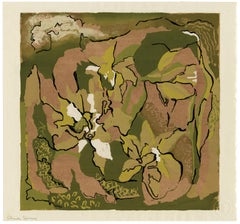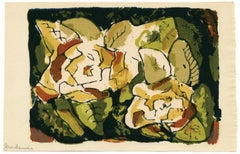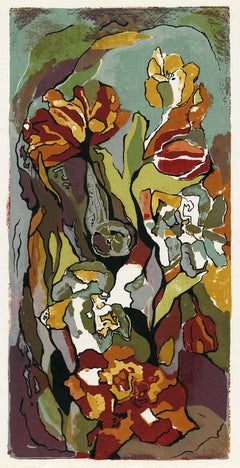Mary Van Blarcom Figurative Prints
1913-1953
Painter, printmaker and craftsperson, Mary Van Blarcom was born in Newark, New Jersey and studied at Wellesley College. She was a member of the National Serigraph Society, where she served on the board of trustees from 1945–52 and was first vice-president from 1949–51. Van Blarcom was also a member of the National Association of Women Artists, the Artists Equity Association, the American Color Print Society, the New Jersey Art Association (Director), and the Artists of Today. She exhibited actively throughout the 1940s at many prominent art organizations.
to
2
3
Overall Width
to
Overall Height
to
3
3
828
375
361
308
3
3
2
1
2
2
1
1
1
1
1
1
3
3
Artist: Mary Van Blarcom
'Crown of Roses' — Mid-century Modernism
By Mary Van Blarcom
Located in Myrtle Beach, SC
Mary Van Blarcom, 'Crown of Roses', color serigraph, c. 1945, edition not stated but small. Signed in pencil beneath the image, lower left. Titled in pencil, bottom left sheet corner. A rich painterly impression, with fresh colors, on cream laid paper, with full margins (3/8 to 7/8 inch), in excellent condition. Matted to museum standards, unframed.
Image size 8 13/16 x 12 11/16 inches; sheet size 9 1/2 x 8 5/16 inches.
ABOUT THE ARTIST
Painter, printmaker, and craftsperson, Mary Van Blarcom was born in Newark, New Jersey, and studied at Wellesley College. She was a member of the National Serigraph Society, where she served on the board of trustees from 1945 through 1952 and was 1st vice-president from 1949-51. She was also a member of the National Association of Women Artists, the Artists Equity Association, the American Color Print Society, the New Jersey Artists Association (Director), and Artists of Today.
Van Blarcom exhibited actively throughout the 1940s at many prominent art organizations, including Montclair Art Museum, 1941-45 and 1947-51 (prize, 1948); Society of Independent Artists, 1942-44; Artists of Today, 1942-46; Elisabeth Ney Museum, 1943; Northwest Printmakers, 1944, 1946-49; Laguna Beach Art Association, 1945-47, 1949; National Association of Women Artists, 1945-50, (prize, 1946); Library of Congress, 1946-47; Museum of Modern Art Traveling Exhibition, 1945-47; Carnegie Institute, 1947; Serigraph Gallery, 1946, 1951 (solo); American Color Print Society, 1947-52; Newark Museum, 1947-48, 1951; California State Library, 1947, 1949; National Serigraph Society, 1949 (prize), 1950 (prize); University of Chile, 1950; New Jersey State Museum, 1950; Philadelphia Art Alliance, 1951; and the Main Gallery, NY, 1952.
Van Blarcom’s work is represented in the collections of the Newark Public Library, the U.S. Library of Congress; the American Association of University Women; the New York Public Library; Tel-Aviv Museum, Alabama Polytechnic Institute, Princeton Print Club...
Category
1940s American Modern Mary Van Blarcom Figurative Prints
Materials
Screen
$320 Sale Price
20% Off
'China Spring' — Mid-Century Floral Abstraction
By Mary Van Blarcom
Located in Myrtle Beach, SC
Mary Van Blarcom, 'China Spring', color serigraph, c. 1945, edition not stated but small. Signed in pencil in the image, lower right. Titled in pencil, bottom left sheet edge. A rich, painterly impression, with fresh colors, on cream laid paper; with full margins (9/16 to 1 5/16 inches), in excellent condition. Matted to museum standards, unframed.
Image size 10 3/4 x 10 3/4 inches; sheet size 11 15/16 x 12 5/8 inches.
ABOUT THE ARTIST
Painter, printmaker, and craftsperson, Mary Van Blarcom was born in Newark, New Jersey, and studied at Wellesley College. She was a member of the National Serigraph Society where she served on the board of trustees from 1945 through 1952 and was 1st vice-president from 1949-51. She was also a member of the National Association of Women Artists, the Artists Equity Association, the American Color Print Society, the New Jersey Artists Association (Director), and Artists of Today.
Van Blarcom exhibited actively throughout the 1940s at many prominent art organizations including: Montclair Art Museum, 1941-45 and 1947-51 (prize, 1948); Society of Independent Artists, 1942-44; Artists of Today, 1942-46; Elisabeth Ney Museum, 1943; Northwest Printmakers, 1944, 1946-49; Laguna Beach Art Association, 1945-47, 1949; National Association of Women Artists, 1945-50, (prize, 1946); Library of Congress, 1946-47; Museum of Modern Art Traveling Exhibition, 1945-47; Carnegie Institute, 1947; Serigraph Gallery, 1946, 1951 (solo); American Color Print Society, 1947-52; Newark Museum, 1947-48, 1951; California State Library, 1947, 1949; National Serigraph Society, 1949 (prize), 1950 (prize); University of Chile, 1950; New Jersey State Museum, 1950; Philadelphia Art Alliance, 1951; and the Main Gallery, NY, 1952.
Van Blarcom’s work is in the collections of the Newark Public Library, U.S. Library of Congress; the American Association of University Women; New York Public Library; Tel-Aviv Museum, Alabama Polytechnic Institute, Princeton Print Club...
Category
1940s American Modern Mary Van Blarcom Figurative Prints
Materials
Screen
$360 Sale Price
20% Off
'Gardenias' — Mid-Century Floral Abstraction
By Mary Van Blarcom
Located in Myrtle Beach, SC
Mary Van Blarcom, 'Gardenias', color serigraph, c. 1945, edition small. Signed 'Van B' in pencil in the image, lower right. Titled in pencil, bottom left sheet corner. A rich, painterly impression, with fresh colors, on cream wove paper; the full sheet with margins (5/16 to 1 1/16 inches), in excellent condition. Image size 6 x 8 3/8 inches; sheet size 6 7/8 x 10 1/4 inches. Matted to museum standards, unframed.
ABOUT THE ARTIST
Painter, printmaker and craftsperson, Mary Van Blarcom was born in Newark, New Jersey and studied at Wellesley College. She was a member of the National Serigraph Society where she served on the board of trustees from 1945 through 1952 and was 1st vice-president from 1949-51. She was also a member of the National Association of Women Artists, the Artists Equity Association, the American Color Print Society, the New Jersey Artists Association (Director), and Artists of Today.
Van Blarcom exhibited actively throughout the 1940’s at many prominent art organizations including: Montclair Art Museum, 1941-45 and 1947-51 (prize, 1948); Society of Independent Artists, 1942-44; Artists of Today, 1942-46; Elisabeth Ney Museum, 1943; Northwest Printmakers, 1944, 1946-49; Laguna Beach Art Association, 1945-47, 1949; National Association of Women Artists, 1945-50, (prize, 1946); Library of Congress, 1946-47; Museum of Modern Art travelling exhibition, 1945-47; Carnegie Institute, 1947; Serigraph Gallery, 1946, 1951 (solo); American Color Print Society, 1947-52; Newark Museum, 1947-48, 1951; California State Library, 1947, 1949; National Serigraph Society, 1949 (prize), 1950 (prize); University of Chile, 1950; New Jersey State Museum, 1950; Philadelphia Art Alliance, 1951; and the Main Gallery, NY, 1952.
Van Blarcom’s work is in the collections of the Newark Public Library, U.S. Library of Congress; the American Association of University Women; New York Public Library; Tel-Aviv Museum, Alabama Polytechnic Institute, Princeton Print Club...
Category
1940s American Modern Mary Van Blarcom Figurative Prints
Materials
Screen
Related Items
Headstand (San Francisco Museum of Modern Art) - Exhibition Poster
By Keith Haring
Located in Paris, IDF
Keith Haring
Headstand
Original vintage exhibition Poster printed in Screenprint
On thick paper
90 x 60 cm (c. 36 x 24 in)
INFORMATION: Official screenprint poster for the Haring e...
Category
1980s American Modern Mary Van Blarcom Figurative Prints
Materials
Screen
Swimmer - Screenprint (Olympic Games Munich 1972)
By Ronald Brooks Kitaj
Located in Paris, IDF
Ronard Brooks KITAJ
Swimmer
Screen print
Signature printed in the plate
On heavy paper 101 x 64 cm (c. 40 x 26 inch)
Made for the Olympic Games in Munich, 1972
Excellent condition
Category
1970s American Modern Mary Van Blarcom Figurative Prints
Materials
Screen
Ratfinkbonerthunk : Surrealist Rat - Original Giclee Print, Handsigned
By Kenny Scharf
Located in Paris, IDF
Kenny Scharf
Ratfinkbonerthunk : Surrealist Rat, 1990
Original Giclee Print
Handsigned in pencil
On Arches vellum 56 x 76 cm (c. 22 x 30 in)
Published by Editions Vermorel in 1990
...
Category
1990s American Modern Mary Van Blarcom Figurative Prints
Materials
Giclée, Screen
$1,797
H 22.05 in W 29.93 in
Jazz : Swing Guy (Yellow) - Screenprint Poster, Montreux, 1983
By Keith Haring
Located in Paris, IDF
Keith Haring
Swing Guy (Yellow), 1983
Screenprint
Printed signature in the plate
On heavy paper 100 x 70 cm (c. 40 x 28 in)
Created by Haring for the Montreux Jazz Festival
Excelle...
Category
1980s American Modern Mary Van Blarcom Figurative Prints
Materials
Screen
$718
H 39.38 in W 27.56 in
Stewart Wheeler, Atlantic City (New Jersey)
Located in New York, NY
The little that is know about the painter and printmaker Stewart Wheeler indicates that most of his career was spent in Philadelphia, Pennsylvania. And...
Category
Mid-20th Century American Modern Mary Van Blarcom Figurative Prints
Materials
Screen
Original Les Codes de CHANEL French fashion poster
Located in Spokane, WA
Original Les Codes de CHANEL Poster – Pink Fashion Wall Art, Modern Luxury Décor, Iconic Designer Brand Print for Bedroom, Living Room, Glam Office poster. Archival linen backed in...
Category
2010s American Modern Mary Van Blarcom Figurative Prints
Materials
Screen
Flowers - Original Screen Print - Handsigned and /100 (Schellman II.101)
By Andy Warhol
Located in Paris, IDF
Andy Warhol (1928-1987)
Flowers (black and white), 1986
Original silkscreen (Printer Alexander Heinrichi, New York)
Signed in pencil with the monogram lower right
Countersigned in p...
Category
1980s American Modern Mary Van Blarcom Figurative Prints
Materials
Screen
$10,784
H 40.56 in W 27.17 in
Black Break, Screenprint by LeRoy Neiman
By LeRoy Neiman
Located in Long Island City, NY
Artist: LeRoy Neiman, American (1921 - 2012)
Title: Black Break
Year: 1973
Medium: Serigraph, signed and numbered in pencil
Edition: AP, 300
Size: 26 in. x 20.2 in. (66.04 cm x 51.3...
Category
1970s American Modern Mary Van Blarcom Figurative Prints
Materials
Screen
Original Mardi Gras New Orleans 1978 festival serigraph poster
Located in Spokane, WA
Original Mardi Gras, New Orleans, 1978 linen-backed poster. Dressed up in what would be an American Indian costume with full headgear, he is holding a shield with a horse on it. Indian decoration on the footwear. Signed and numbered.
I believe this has to deal with Big Chief leading his Congo Nation Mardi Gras Indian group. Zulu Parade. Many of the original Mardi Gras jazz posters...
Category
1970s American Modern Mary Van Blarcom Figurative Prints
Materials
Screen
$636 Sale Price
20% Off
H 32 in W 23 in D 0.05 in
Original "Wagon Lits" pop art style serigraph travel by train poster
By Valerio Adami
Located in Spokane, WA
Original “Wagon Lits” serigraph poster by the artist Valerio Adami.
It was printed in France by GrafiCaza (Michel Caza), one of the finest serigraph companies on woven paper—in exce...
Category
1990s American Modern Mary Van Blarcom Figurative Prints
Materials
Screen
$260 Sale Price
20% Off
H 36 in W 24 in D 0.05 in
The Cat, Signed Modern Screenprint by Will Barnet
By Will Barnet
Located in Long Island City, NY
Artist: Will Barnet, American (1911 - 2012)
Title: The Cat
Year: 1997
Medium: Screenprint on Arches, signed in pencil
Edition: AP
Image Size: 16 x 7 inches
Siz...
Category
1990s American Modern Mary Van Blarcom Figurative Prints
Materials
Screen
Original Les Codes de CHANEL (black version) French fashion perfume poster
Located in Spokane, WA
Original Les Codes de CHANEL Poster – Black Fashion Wall Art, Modern Luxury Décor, Iconic Designer Brand Print for Bedroom, Living Room, Glam Office poster. Archival linen backed in ...
Category
Early 2000s American Modern Mary Van Blarcom Figurative Prints
Materials
Screen
$400
H 28 in W 22 in D 0.3 in
Previously Available Items
'Surgent Spring' — Mid-century Floral Abstraction
By Mary Van Blarcom
Located in Myrtle Beach, SC
Mary Van Blarcom, 'Surgent Spring', color serigraph, c. 1945. Signed in pencil in the image, lower right. Titled in pencil, bottom left sheet corner. A rich, painterly impression, with fresh colors, on cream laid paper; the full sheet with margins (3/8 to 3 1/2 inches); slight water stain in the top left sheet corner, well away from the image, otherwise in excellent condition. Image size 24 1/4 x 11 7/8 inches; sheet size 19 x 25 1/8 inches. Matted to museum standards, unframed.
ABOUT THE ARTIST
Painter, printmaker, and craftsperson, Mary Van Blarcom was born in Newark, New Jersey, and studied at Wellesley College. She was a member of the National Serigraph Society, where she served on the board of trustees from 1945 through 1952 and was 1st vice-president from 1949-51. She was also a member of the National Association of Women Artists, the Artists Equity Association, the American Color Print Society, the New Jersey Artists Association (Director), and Artists of Today.
Van Blarcom exhibited actively throughout the 1940s at many prominent art organizations including Montclair Art Museum, 1941-45 and 1947-51 (prize, 1948); Society of Independent Artists, 1942-44; Artists of Today, 1942-46; Elisabeth Ney Museum, 1943; Northwest Printmakers, 1944, 1946-49; Laguna Beach Art Association, 1945-47, 1949; National Association of Women Artists, 1945-50, (prize, 1946); Library of Congress, 1946-47; Museum of Modern Art traveling exhibition, 1945-47; Carnegie Institute, 1947; Serigraph Gallery, 1946, 1951 (solo); American Color Print Society, 1947-52; Newark Museum, 1947-48, 1951; California State Library, 1947, 1949; National Serigraph Society, 1949 (prize), 1950 (prize); University of Chile, 1950; New Jersey State Museum, 1950; Philadelphia Art Alliance, 1951; and the Main Gallery, NY, 1952.
Van Blarcom’s work is in the collections of the Newark Public Library, U.S. Library of Congress, the American Association of University Women, New York Public Library, Tel-Aviv Museum, Alabama Polytechnic Institute, Princeton Print Club...
Category
1940s American Modern Mary Van Blarcom Figurative Prints
Materials
Screen
Mary Van Blarcom figurative prints for sale on 1stDibs.
Find a wide variety of authentic Mary Van Blarcom figurative prints available for sale on 1stDibs. You can also browse by medium to find art by Mary Van Blarcom in screen print and more. Much of the original work by this artist or collective was created during the 1940s and is mostly associated with the modern style. Not every interior allows for large Mary Van Blarcom figurative prints, so small editions measuring 9 inches across are available. Customers who are interested in this artist might also find the work of Bernard Brussel-Smith, Harry Sternberg, and Caroline Durieux. Mary Van Blarcom figurative prints prices can differ depending upon medium, time period and other attributes. On 1stDibs, the price for these items starts at $350 and tops out at $680, while the average work can sell for $475.
Artists Similar to Mary Van Blarcom
Razzia (Gérard Courbouleix–Dénériaz)



